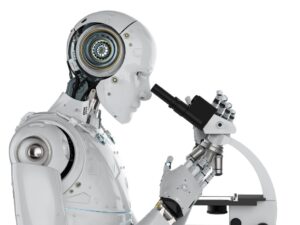Pathologists Shortages and Artificial Intelligence
 “It isn’t knowledge that’s making trouble, but the uses it’s put to.” – Kurt Vonnegut
“It isn’t knowledge that’s making trouble, but the uses it’s put to.” – Kurt Vonnegut
As a resident, my chief of anatomic pathology, who was Mexican born and spoke perfect Spanglish told me, “Señor, you have to know the 3 Gs and the D – GI, Gyn, GU and Derm.” She was referring to gastrointestinal, gynecologic, genitourinary and dermatopathology. Whether she knew the broader data and Medicare data, for instance, she recognized in practice, about 70% of our volume, the material we saw daily, was from these 4 subspecialties. Biopsies easily accessed with minimal invasiveness. Breast, brain, bone/soft tissue, hepatobiliary, lung, kidney and so forth make up the rest of the 30%.
Furthermore, of the 70% made of the 3Gs and the D, common things occur commonly, ranging from normal to minimally abnormal to a confirmation of the clinical impression, endoscopic picture, cystoscopic findings or physical examination of the skin lesion correlated with clinical history.
Clinical impressions such as “R/O BCC” or “SK” or “AK” often times are what they are. An upper endoscopy performed for abdominal pain which is absent any gross pathologic findings, is often normal. More endometrial biopsies, prostate biopsies and breast biopsies are normal rather than abnormal, and we can confirm normal tissue, minimal benign disease or the absences of significant clinical disease.
I once asked a well-known gynecologic pathologist at a large teaching hospital on the East coast what percent of normal endometrial biopsies he sees in his consult practice. He responded by telling me, “Keith, I spend 93% of my practice describing to other pathologists and clinicians normal biopsies.”
As a young attending, one of my colleagues was there early in the morning, I asked what he had been doing, he responded by telling me “I signed out 10 trays of GI biopsies and didn’t have enough pathologic findings to fill up one tray”.
In my own experience over 20+ years of practice, at least 7 out of 10 breast biopsies acquired after screening mammograms are benign. Tumors that have been neglected and involve the skin or axilla grossly of course are malignant.
GI biopsies, it could be argued, have a high negative predictive value of having significant disease when the endoscopist reports no gross findings. Again, gross findings, mass lesions, polyps, and so forth correlate with pathologic findings that may be clinically significant or not.
The point of all this being, while we use artificial intelligence (AI) to find the rare, isolated tumor cell, rare microorganism or rare atypical gland, the vast majority of what we do is confirming the absence of disease, with the exception of dermatopathology, where we confirm the clinical impression and insure the pigmented BCC is not melanoma or the clinical melanoma is a less offensive pigmented BCC.
There is strong precedence for this in pathology that has existed now for over 20 years. The development of liquid-based cytology and automated pre-screening, through all the trials and tribulations of the 90s with multiple vendors competing for FDA approval and approved clinical acceptance, has long been standard of care with exclusion of normal specimens in a screening population with routine QA and manual review of even the most slightly abnormal pap smears.
Arguably, the same rules and regulations could be put in place for “screening” biopsies done for abnormal mammograms, elevated PSA or normal endoscopies and colonoscopies. Pre-screening of normal and/or essentially normal biopsies with some percent of QA for review and filtering of even the least abnormal for manual review.
As the College of American Pathologists predicted 10 years ago, there would be a pathologist shortage beginning in 2015. Perhaps it was increased by the public health events of 2020 and 2021. Nonetheless, here we are. The endless emails, letters, texts and phone calls from recruiters, hospitals, groups and locum tenens companies for the past several years have confirmed our own internal shortages.
This however will not survive this decade. As clinically approved algorithms become increasingly available, fewer pathologists will be needed. Some of the work of pathologists will be supplanted by algorithms. The tedious, mundane, routine tasks of dictating normal biopsies can be eliminated, allowing for the pathologist workforce to focus on the exquisite, unusual, unexpected and/or frankly bizarre cases. This is not a bad thing necessarily. As the saying goes, “ugliness is a point of view; an ulcer is wonderful to a pathologist”.
There are many unanswered questions here beyond the technology, who pays for it, who “owns” it, who gets reimbursed for it, etc…Those details, as they always are, will get debated, discussed and decided.
For me, I realize this will allow me more time to find what I need in the grocery or hardware store and then learn the cash register system to check myself out.
I mean have you been to The Home Depot recently? The only folks wearing the orange aprons are the people watching you struggle knowing where the bar codes is and where to put your credit card in the machine. There used to be people in the back showing you the small section where they kept the left-handed screwdrivers or the brackets you didn’t think existed but suddenly need to have a whole box of. We too, as pathologists, will become like the guys who used to wear the orange aprons at The Home Depot, resigned to watching over the machines and checking their work occasionally. As the comedian Jim Gaffigan says “I am not worried about AI, I look forward to it, bring it on, because I am exhausted, when something else can stand up here and do this it will be great!”
“Those who live by electronics, die by electronics. Sic semper tyrannis.” – Kurt Vonnegut
We just have to make sure we don’t become part of the reeks and wrecks.

































